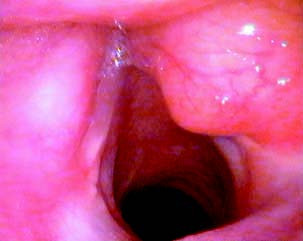Laryngeal amyloidosis, also known as laryngeal amyloid tumor, refers to a pathological condition caused by the deposition of amyloid material in the larynx. It is not a true neoplasm. Amyloidosis most commonly occurs in the respiratory tract, particularly in the larynx, and can affect any part of the larynx. The supraglottic region, especially at the ventricular fold level, is the most frequently involved site. This condition is more common in individuals aged 50 to 70 years and is predominantly observed in males.
Etiology
The pathogenesis of laryngeal amyloidosis remains incompletely understood. It is often attributed to long-term chronic inflammatory stimulation in the larynx, resulting in immune dysregulation, obstruction of lymphatic and blood circulation, local protein metabolism disturbances, and accumulation of globulins. Additionally, it may be associated with familial inheritance, systemic conditions such as multiple myeloma or primary macroglobulinemia, as well as degenerative changes in local tumors.
Clinical Manifestations
Laryngeal amyloidosis typically has a prolonged disease course with slow progression. Clinical manifestations primarily depend on the location and extent of the lesions. Common symptoms include hoarseness, a dry sensation in the throat, foreign body sensation, and irritative coughing. When the vocal folds or ventricular folds are affected, the primary symptoms often involve hoarseness, a sensation of a foreign body in the throat, and irritative coughing. Patients with extensive lesions or airway narrowing caused by the lesions may experience breathing difficulties. Laryngeal amyloidosis generally does not cause vocal fold fixation or cervical lymph node metastasis.
Diagnosis
The diagnosis is challenging and may require a combination of clinical symptoms and auxiliary examinations. Laryngeal amyloidosis cannot be reliably distinguished from granulomas, polyps, or other masses based on macroscopic appearance alone. Typical findings under laryngoscopy include red or yellow elevations on the vocal folds, laryngeal ventricles, ventricular folds, or subglottic regions. The lesions may also appear as diffuse subepithelial infiltrations, with significant narrowing of the glottis.

Figure 1 Laryngeal amyloidosis
Definitive diagnosis is achieved through pathological biopsy. Histopathological sections reveal amyloid deposits in the submucosal connective tissue. Congo red staining demonstrates the amyloid material as red or brick-red, which serves as the gold standard and the most specific histochemical test for diagnosing amyloidosis.
Differential Diagnosis
Laryngeal Cancer
Common symptoms include hoarseness, hemoptysis, and foreign body sensation. Extensive lesions may lead to obstructive breathing difficulties and dysphagia. Laryngoscopy may show an irregular, cauliflower-like mass with easy bleeding upon contact, along with vocal fold motion impairment and cervical lymphadenopathy. Definitive diagnosis is established through pathological examination.
Vocal Cord Polyp
Primary symptom is hoarseness. Polyps are usually located at the anterior-middle third of the vocal fold, appearing reddish, soft, and smooth, with normal vocal fold mobility. Pathological examination confirms the diagnosis.
Laryngeal Chondroma
Symptoms may include progressive hoarseness, dysphagia, and a sensation of a foreign body in the throat. Laryngeal chondromas may present as pale blue, translucent, lobular masses. Imaging studies are valuable, revealing a tumor located within the laryngeal cartilage. Pathological examination confirms the diagnosis.
Laryngeal Plasmacytoma
This condition occurs more frequently in middle-aged and elderly males, typically as a solitary lesion. Symptoms may include abnormal phonation, throat discomfort, or choking during meals. Examination may reveal a pedunculated or broad-based mass with a smooth or nodular surface. Pathological examination confirms the diagnosis.
Laryngeal Keratosis
Symptoms may include hoarseness and throat discomfort, without accompanying breathing difficulties. Examination reveals patchy lesions on one or both vocal folds, appearing white and firmly adherent. Glottic closure may be incomplete. Pathological examination provides a definitive diagnosis.
Treatment
The primary goals of treatment are to ensure airway patency and to improve or restore vocal quality.
Once diagnosed, surgical resection is the main approach. For cases with limited lesion extent, glucocorticoid therapy or lesion removal under suspension laryngoscopy may be appropriate. In recent years, CO2 laser treatment has shown satisfactory outcomes due to reduced scarring. For lesions with a broad base, laryngofissure surgery may be necessary to excise the affected tissue.